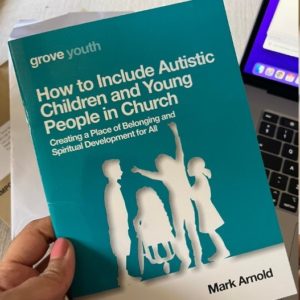Title: How to include autistic children and young people in church – Creating a place of belonging and spiritual development for all
Author: Mark Arnold
 Published by: Grove Youth series
Published by: Grove Youth series
Price: £3.95
Good for: anyone involved in church, especially church and group leaders
Best bit: Simple, quick to read with immediate take aways
Worst bit: There wasn’t much about how the autistic spectrum and differences between people with autism
More:
This book is a really quick read (30 minutes will probably do it) but could totally transform the way your church includes autistic children and young people!
Mark is an experienced special needs Dad and practitioner, training churches across the country in how to better include everyone.
This book is very well written, easy to read and gives clear advise, while not assuming that all autistic people and all churches will need the same things!
Mark is very clear from the beginning that the best way to remove barriers and make church for everyone is to work with not for autistic people. He suggests doing a church audit with an autistic person, looking at the different elements which someone might find a barrier. He gives examples of what these things might be, but insists that this is something we need to do in our own context to see what the barriers are there. I find this very helpful as it is not too prescriptive and allows for differences, which is exactly what Mark is advocating!
Mark is also not insisting on a total change in how we do church, but rather looking for “simple changes and adaptions [which] can be made … so that everyone is welcome, everyone can take part, and everyone’s needs are considered and acted upon.”
Anyone curious about inclusion should read this book. It is challenging enough to give us all something to do, but accessible enough to allow us to get going right away.
He suggests a few things which would help include autistic children and young people (and I would suggest, also adults many of whom have never been diagnosed), such as avoiding religious metaphors (e.g. being washed in the blood of the lamb) and giving notice of changes to give people time to transition. Many of these things are easy to do once you know!
There is also a mini-Bible study at the back called 10 ways to create belonging for everyone, which would make a great Bible study or talk, with 10 Bible verses with questions for people to explore.
